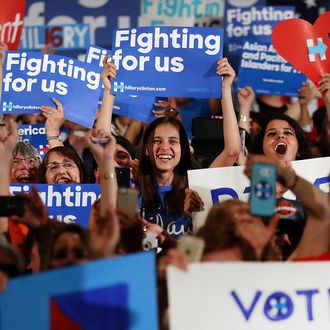
The heartburn among Democrats about “Bernie or bust” voters who may resist pleas to turn out in November for Hillary Clinton is about young people. They’ve preferred Sanders to Clinton during the nomination contest by vast margins, even within racial or ethnic groups that otherwise favored Hillary. They are disproportionately self-identified independents, which means putting on the party yoke sounds like bondage rather than solidarity. And they are the classic marginal voters, thanks to high levels of personal mobility and low levels of political engagement.
Clinton, moreover, is a two-time loser among young voters, having been beaten by Barack Obama among under-30 voters by nearly as large a margin in 2008. Solid as she seems to be with the other big element of the Obama coalition, minority voters, millennials are simply not a natural constituency for her.
But will that matter crucially in November? The New Republic’s Brian Beutler argues that it won’t, in part because the Kidz weren’t as big a deal for Obama (especially in 2012, when he won despite a significant drop in turnout from under-30s) as some have imagined. And then there’s the Trump factor: A Republican candidate far more distasteful to young voters than Clinton should help her in that demographic with or even without a great deal of effort from Democrats.
Without question, Beutler is right that Obama weathered a drop-off in both under-30 voter participation (from 17 percent of the electorate to 15 percent) and support levels (from 66 percent to 60 percent) between 2008 and 2012. That limits the damage another drop-off could inflict on the Democratic nominee this time around.
As for the impact among millennial voters of Republicans choosing Trump as their nominee, the best evidence we have is from a large-sample survey by Harvard’s Institute of Politics in April and May (i.e., the height of the Sanders phenomenon) that shows Clinton trouncing Trump among under-30 likely voters by a 61-25 margin, pretty comparable to Obama’s performance in 2008. This number is impressive in part because it exists despite meh assessments of Clinton herself: Her favorability ratio among under-30s is pretty far underwater at 37-53 (compared to Bernie Sanders at 54-31). But Trump is at the bottom of the sea with a ratio of 17-74. Clinton goes into the general-election campaign with a sizable advantage among young people even before Bernie Sanders and other validating figures lift a finger to help her.
In general, for all the talk about Trump’s dangerous appeal to white working-class voters, Clinton is very lucky to have drawn an opponent who probably caps at a very low level any potential defections from the Obama coalition of African-American, Latino, and under-30 voters (it should also be kept in mind that under-30s are disproportionately nonwhite). Looking at demographics more broadly, Trump and the identification of the GOP with his loudly dubious views could help Democrats ensure that the Obama coalition lives on for a good long while after the 44th presidency ends.






























